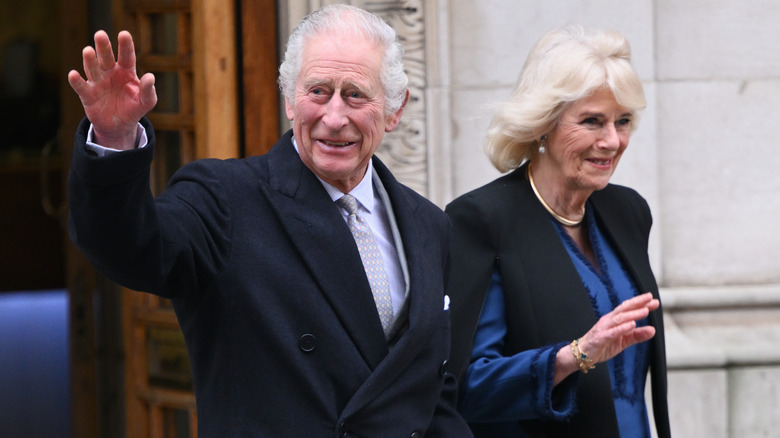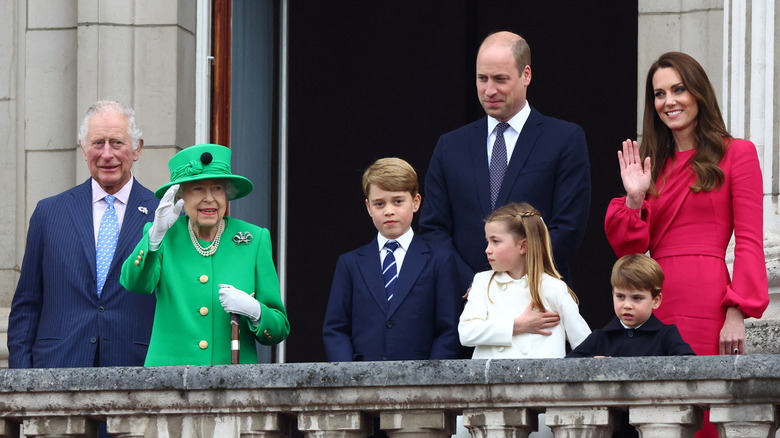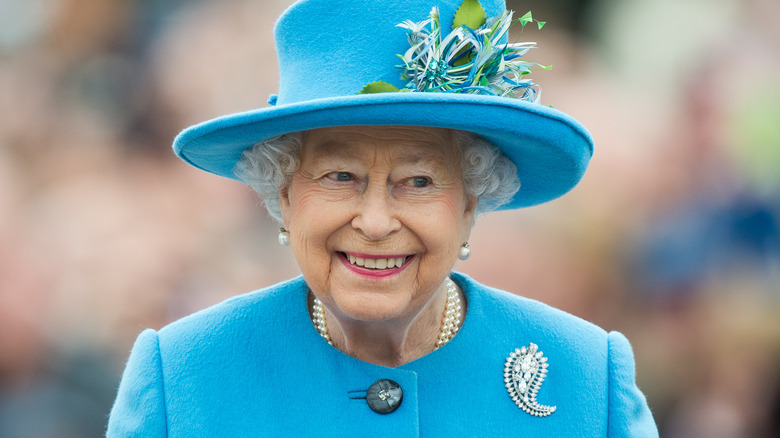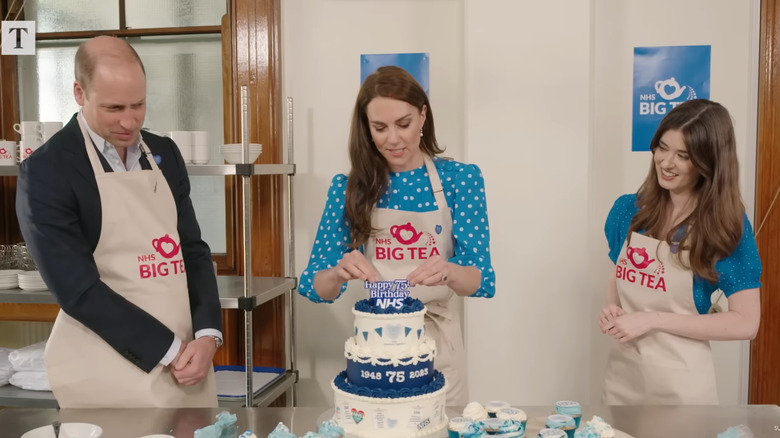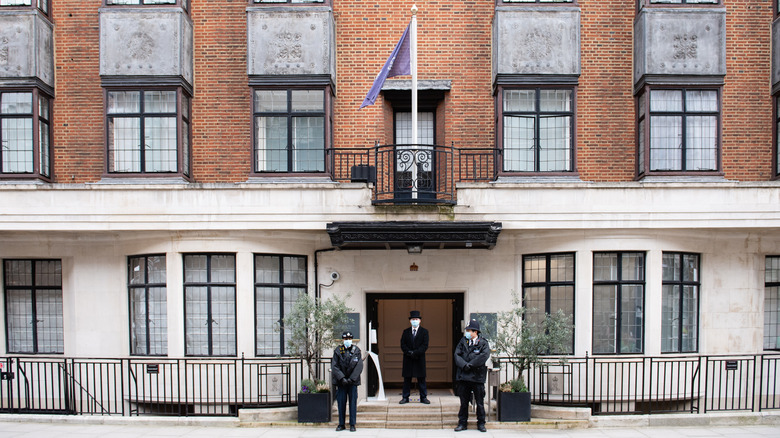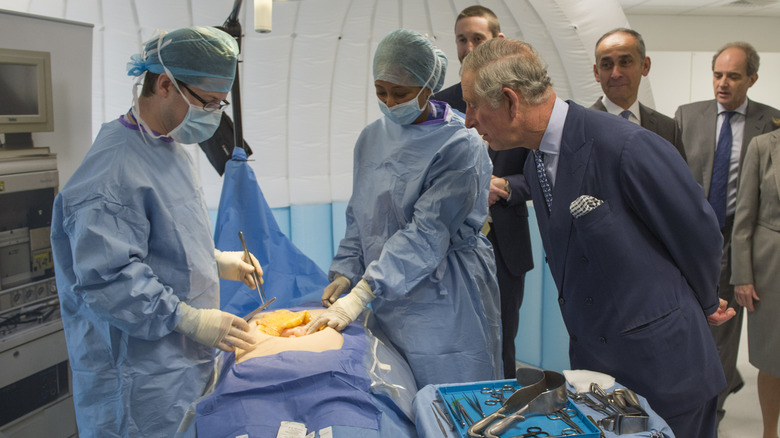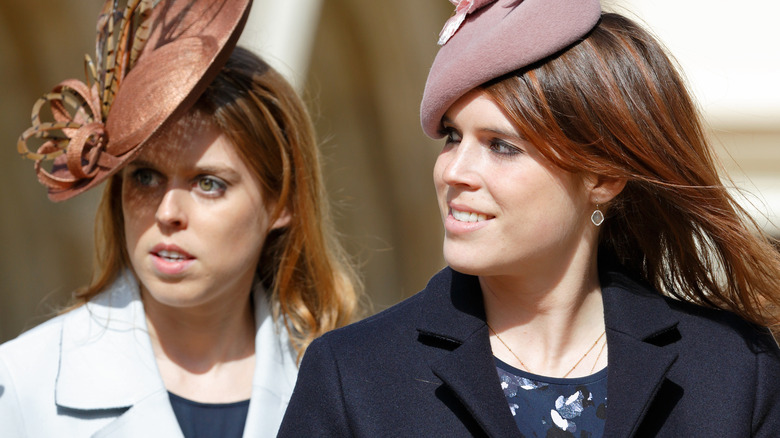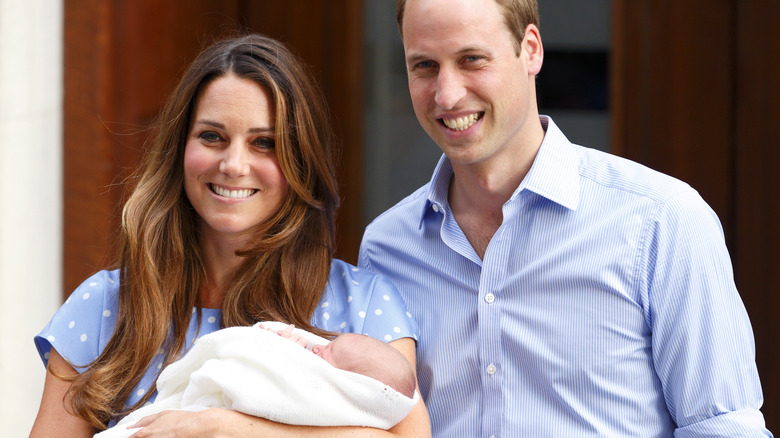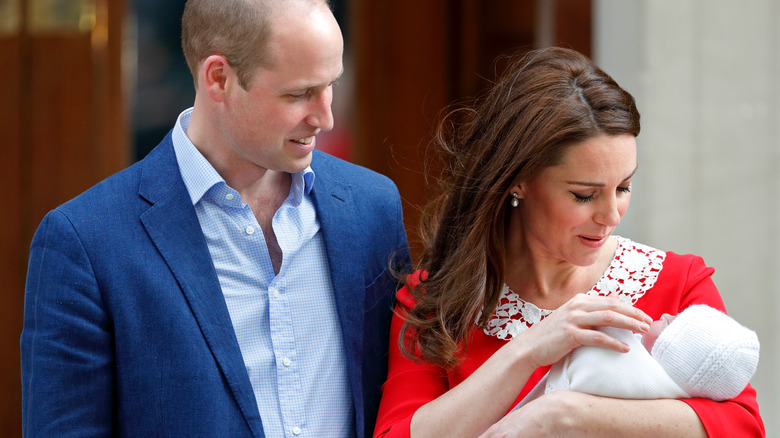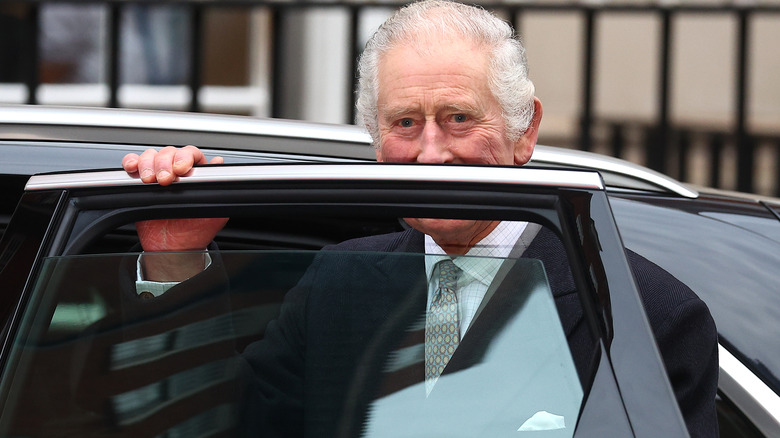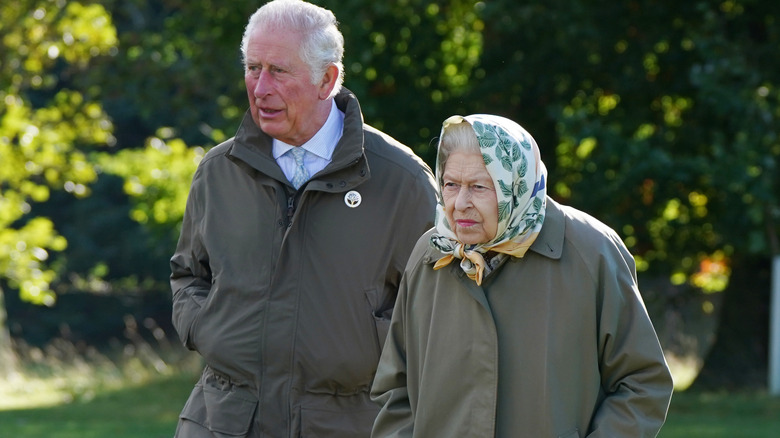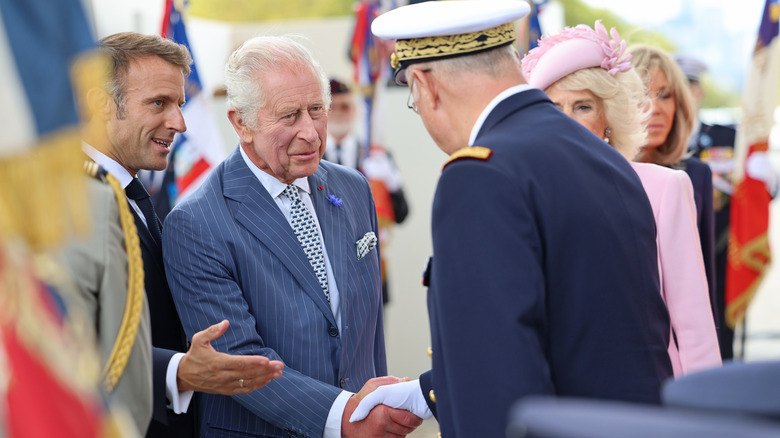Here's How The Royal Family's Healthcare Really Works
Queen Elizabeth II ruled for 70 years, making her Britain's longest-reigning monarch in history. She was woven into the very fabric of the world this generation inhabits — presidents and prime ministers came and went, but the queen remained the one constant for seven decades. Therefore, one would be forgiven for, perhaps, forgetting that she wasn't immortal. She sure seemed like an immortal being — she'd just always been there, a steady presence and the face of the British monarchy. When she died in September 2022, it served as a reminder that death comes for us all — even the royalty among us. Of course, the queen looking as good and being as healthy as she was at her age was, in part, thanks to quality healthcare.
While many of the monarchy's traditions might appear ancient, their healthcare kept up with the times. For instance, Queen Elizabeth's father, King George VI, underwent a procedure to remove his left lung in Buckingham Palace's Buhl Room in 1951, but now the royal family goes to prestigious hospitals. Very recently, King Charles III and Princess Catherine were admitted to the London Clinic to undergo surgery — Charles for an enlarged prostate, and Catherine for abdominal surgery. Naturally, the public was concerned for the two royals, but if there's one thing we can know for sure, it's that this family receives the best healthcare there is — from fancy hospitals to renowned physicians, it might be safe to say that their medical bills would take your breath away.
The royals have an in-house medical team
Imagine not having to call to make an appointment with a doctor when you're feeling ill but instead picking up the phone to summon them straight to your doorstep. That's the royal medical treatment members of the monarchy get to enjoy, thanks to the Royal Medical Household. This division of Buckingham Palace is responsible for taking care of the health of the monarch as well as other working members of the royal family. Doctors who opt to work for the monarchy in this capacity need to contend with the fact that they are on call permanently, which must make taking a vacation once in a while challenging. The monarch has their own physician, and the medical household is headed by a doctor of the monarch's choice.
Physicians who work for the monarchy get to have the best of both worlds, in a sense — while there is the downside of always being on call, they don't have to be at the palace 24/7. Instead, they pay a visit to the royals whenever they require their services, which means they can take on other work as well. In fact, many royal physicians work at other hospitals or have private practices. Speaking to the Daily Mail in 2022, a palace spokesperson explained that the palace employs a variety of doctors based on their skill sets.
The monarch gets to choose the head of the Royal Medical Household
The head of the Royal Medical Household is a sought-after job, and Queen Elizabeth II's physician, Sir Huw Thomas, described the position as "a great honor" and "a very enjoyable and rewarding role" during an interview with Imperial College London. He explained that treating members of the monarchy wasn't much different from treating ordinary patients. However, the royal physician becomes a part of the institution. "[You] become the personal doctor to the principal people in it, who are patients just like other patients," he explained.
When the queen died, King Charles III had to choose his personal physician, and his choice met with some criticism. While Sir Huw Thomas was a gastroenterologist, Charles' new doctor, Michael Dixon, specializes in homeopathy. He is known for favoring homeopathic treatments and has actively advocated for its use. In lieu of public criticism, the palace released a statement, clarifying the king's choice and assuring the press that Dixon was indeed a qualified medical doctor. "Dr. Dixon does not believe homeopathy can cure cancer. His position is that complementary therapies can sit alongside conventional treatments, provided they are safe, appropriate, and evidence based," the statement read (via The Independent). The king also used the statement to make it clear that he doesn't reject Western medicine. "In his own words, 'Nor is it about rejecting conventional medicines in favor of other treatments: the term complementary medicine means precisely what it says,'" the statement clarified.
The royal family has made use of the NHS in the past for certain procedures
It's widely known that the royal family are avid supporters of the National Health Service (NHS) — they even hosted and attended several events to celebrate the organization's 75th anniversary. While many have criticized the royals for championing the NHS but not deeming it good enough for their own healthcare, some of them have made use of its services in the past.
When Duchess Sophie of Edinburgh gave birth to her daughter, Lady Louise Windsor in 2003, she did so at an NHS hospital. The staff managed to save Sophie and Louise's life after the duchess suffered a placental abruption. Prince Philip also made use of NHS services when he was treated for a preexisting heart condition at St. Bartholomew's Hospital. Previously, the duke underwent emergency heart surgery in 2011 at the NHS Papworth Hospital. Similarly, Princess Margaret had lung surgery at Royal Brompton Hospital's specialist NHS heart and lung center. Prince Harry also received care from the NHS at the age of 3 when he had to undergo surgery to repair a hernia.
As for why the royals often opt for private hospitals instead of NHS facilities, it's often because they have a security detail accompanying them. Other factors they have to take into consideration are their privacy and how their presence might disrupt other patients' care. At private hospitals, the royals' impact on the day-to-day schedule can be minimized.
Most members of the family prefer the King Edward VII Hospital for major procedures
When it comes to choosing hospitals, the royal family appears to favor King Edward VII's Hospital, which isn't that surprising, really — their ancestor, King Edward VII became the institution's first patron after its establishment in 1899. The hospital specializes in personal care, sporting only 56 beds in total and a low patient-to-nurse ratio. In short, you are your nursing team's center of attention for the duration of your stay, and this is pretty much the treatment the royal family is used to.
Queen Elizabeth II was admitted to this hospital when she had to get knee surgery in 2003, and Camilla, Queen Consort, had her hysterectomy done there in 2007. The hospital continued to remain a favorite among royal family members — when Princess Catherine dealt with severe morning sickness during her pregnancy with Prince George, she was also admitted to the facility, and in 2018, Prince Philip was admitted to King Edward VII's for hip replacement surgery.
More recently, Princess Catherine and King Charles III opted to undergo their respective medical procedures at the London Clinic, which, unsurprisingly, also resembles a hotel more than a medical institution. Its grand opening was conducted by King George VI and Queen Elizabeth in 1932. Aside from offering excellent medical care, it has a concierge and food that resembles that of a Michelin-star chef.
The doctors who treat the royal family aren't always named publicly
While the names of the doctors who treat the royal family aren't exactly a state secret, they aren't always made public. Of course, the head of the Royal Medical Household is usually revealed to the public, but other doctors who have tended to the royals over the years weren't always named. When Princess Catherine gave birth to Prince George, for instance, the palace never named her doctors. Ten years later, however, one of the physicians, Sir Marcus Setchell, admitted to The Telegraph that he assisted Catherine with the birth of George and was pretty nervous about treating a member of the royal family but reminded himself that, in the end, it was just another normal baby.
In the last couple of years before his death, Prince Philip spent plenty of time in hospitals, but the doctors who treated him weren't publicly named by Buckingham Palace. Then, of course, there's the monarch's personal physician. Everyone knew the name of Queen Elizabeth II's physician — Sir Huw Thomas, who also happened to be the head of the Royal Medical Household, but King Charles III opted not to reveal this information. The palace announced that Dr. Michael Dixon is now heading the Royal Medical Household, but later said that the king's personal physician's name would not be made public. This may or may not be because of the criticism Charles received for appointing Dixon, who is an advocate for homeopathic treatments.
If you're not a working royal, you are responsible for your own healthcare
While being a non-working member of the royal family can surely bump you up the social ladder, it won't do the same for your healthcare. Unsurprisingly, those who are not working members need to make arrangements for their own healthcare, which means less esteemed members of the family don't usually frequent outrageously expensive hospitals like King Edward VII's and the London Clinic. Still, just because you're not a senior or working member doesn't necessarily mean that you're broke.
Princess Anne's daughter, Zara Tindall, kept it simple when she gave birth and was admitted to an NHS facility to deliver her first two children. Her third child was in such a hurry to arrive that Zara had no choice but to give birth at home (but thankfully, everything went just fine). Prince Andrew's daughters, Princess Beatrice and Princess Eugenie, might not be working royals, but they're pretty well off financially, and Eugenie favored the private Portland Hospital when she gave birth to her two sons. Her sister was admitted to Chelsea and Westminster Hospital for the birth of her daughter. While these institutions aren't King Edward VII's Hospital, they're still pretty fancy in their own right.
The royals went from favoring home births to preferring the Lindo Wing
Way back when, women in the royal family gave birth much the same way their subjects did — at home. This remained the norm for hundreds of years and only changed when Princess Anne gave birth to both her children, Peter Phillips (in 1977) and Zara Tindall (in 1981), at the Lindo Wing of St. Mary's Hospital. Princess Diana followed in her footsteps with both her children.
Yup, the royal family favored home births for a long time. Queen Elizabeth II was born at her maternal grandparents' house in Mayfair, London, and she would give birth to all of her children at home. The queen gave birth to King Charles III at Buckingham Palace, while Princess Anne was born at Clarence House. Prince Andrew and Prince Edward were also both born at Buckingham Palace instead of a hospital.
Thanks to Princess Anne breaking tradition, royal women now have a choice as to whether or not they want to have a home birth. There was speculation that Meghan Markle was planning a home birth when she was pregnant with Prince Archie (she ended up giving birth at the hospital), and Zara Tindall had a surprise home birth when her third child decided to arrive unexpectedly. Following Princess Anne's decision to give birth at the Lindo Wing at St. Mary's Hospital, royals started to favor the institution, and Prince William and Princess Catherine welcomed all three of their children there.
Royals usually have midwives
In the past, members of the royal family preferred to have a midwife by their side instead of a whole team of doctors — Queen Elizabeth II was one of those people. When Princess Catherine was set to give birth to Prince George, however, it was revealed that she was going to surround herself with a whole birthing crew should anything go wrong.
Speaking to Hello! magazine, consultant obstetrician and gynecologist Professor Tiong Ghee Teoh said that Catherine was surrounded by a massive team. "Anything that could possibly go wrong, we had a team of people behind each speciality," he said. "Everyone was sworn to secrecy." This team of people consisted of four pediatricians, two obstetricians, three anesthetists, four surgical staff members, one lab technician, two special care baby unit staff, and three midwives. Whew! When Charlotte was born, Catherine, who now had some experience with giving birth, only hired two midwives alongside her existing doctors.
While the idea of using midwives might seem a little outdated to some, it's still very much the norm in the U.K. Louise Silverton, who works as a midwife, told The Denver Post that "it's a cultural thing." Certified nurse midwife Angela Ferrari told the outlet that midwives are not only more cost-efficient, but they're also more likely to help the mother deliver her baby without too much unnecessary intervention, meaning that the medical tools doctors tend to employ during birth are often unnecessary when a qualified midwife is around.
Royals require extensive security whenever they are admitted to a hospital
Being a senior member of the royal family means you can't go anywhere without your security detail, and King Charles III and Princess Catherine's recent stints in hospital sparked renewed interest in the royal family's security measures when they venture outside the palace walls. When both Charles, who is the reigning monarch, and Catherine, the future queen, were admitted to the London Clinic for their respective procedures, vast security measures were necessary to ensure their safety for the duration of their stay.
Speaking to Express, former Royal Protection Officer Simon Morgan explained that plenty of intricate planning goes into ensuring the royals' safety when they are admitted to a hospital. Their security detail needs to figure out how to set in place the same measures they implement when the royals are at their residence. "So what you've got to consider is, how do you maintain that in an environment that ordinarily isn't used to, firstly, being like that, bearing in mind this is a hospital," Morgan explained. Usually, the palace's security will evaluate what kind of safety measures the hospital in question already has in place and build on that. "[I]t is a logistical scenario because you're ultimately going from one very proven, known security site to one now that sort of isn't to a certain extent," Morgan said. All of this needs to be pulled off without a hitch while keeping the hospital running normally.
Royals get regular preventative screenings and cultivate healthy routines
Preventative health care is extremely important when it comes to catching and stopping a disease in its tracks. Take King Charles III's recent procedure, for example — the monarch was diagnosed with an enlarged prostate and underwent corrective surgery to prevent any issues in the future. Regular medical screenings can literally be life-saving, so it's no surprise that the royal family makes sure they stay up to date on their medical checkups. Like us normal folks, they get their bloodwork done and go for cancer screenings. They've also been made fun of for taking very good care of their teeth, but if you had to smile at cameras as often as they do, you'd want your pearly whites to look presentable too. Both Prince Harry and Princess Eugenie used to wear braces when they were kids (and now have the stellar smiles to prove it).
Aside from their screenings and bloodwork (and the occasional dental job), members of the family also take care to eat healthy and exercise. King Charles III favors long walks and a plant-based diet. Queen Elizabeth II used to walk her dogs around the Buckingham Palace grounds and continued to do so until the last year of her life, British scientist Andrew Steele told "Today." On "The Emma Barnett Show," Camilla, Queen Consort, said Charles is "probably the fittest man of his age I know. ... He's like a mountain goat. He leaves everybody miles behind."
The monarch always travels with a Royal Navy doctor on board
When the monarch travels overseas, a Royal Navy doctor accompanies them. Before the plane even takes off, the doctor in question is armed with extensive knowledge of the medical facilities available in the country the monarch is traveling to — this way, they are prepared should the sovereign take ill during their travels. Queen Elizabeth II traveled with a Royal Navy doctor before she retired from taking royal tours overseas, and now King Charles III will be doing the same.
Speaking to Hello! magazine, royal reporter Gordon Rayner, who has lived through 20 royal tours, said that few ever notice the doctor who accompanies the monarch, but they are never far from their side. Armed with emergency medicine and a mobile defibrillator, the physician is always ready to perform life-saving measures should the need arise. Before Charles was king, he also had doctors on standby during his royal tours, but his team wasn't as extensive as his mother's. Younger members of the royal family, like Prince William and Prince Harry, didn't travel with a medical team but reportedly had doctors on standby to attend to them in the countries they were visiting.
The monarch and the runner-up to the throne also sometimes travel with their own blood supply. While this may seem rather odd, it's a necessary measure when they visit countries where adequate blood supply is not guaranteed. This blood supply travels with their convoy throughout their royal tour.
